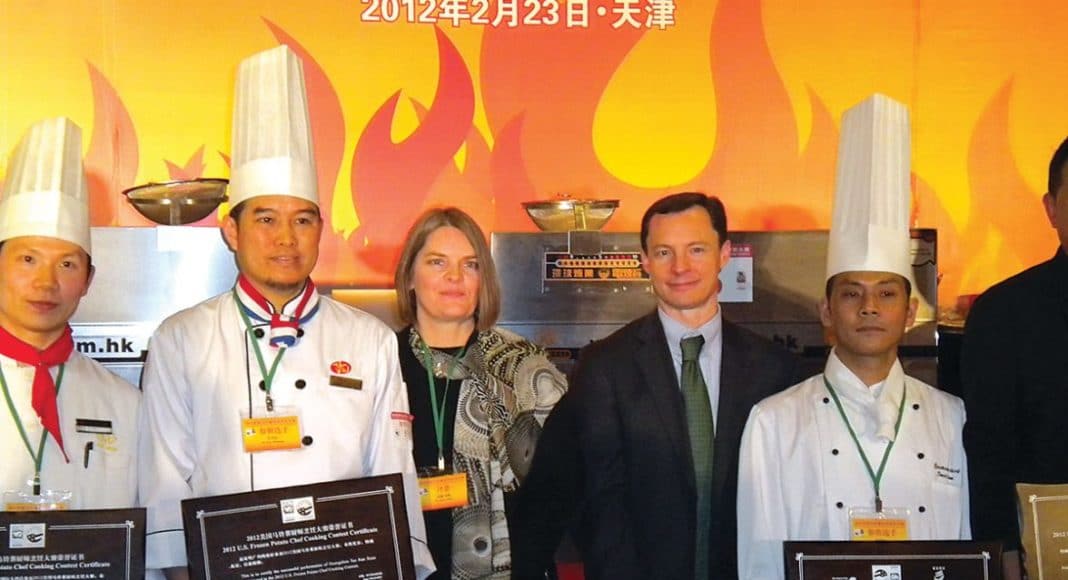[deck]As new trade links become accessible, more potatoes are being shipped each year around the globe. Where does Canada fit in the landscape of international trade?[/deck]
Along with rice, corn and wheat, potatoes are counted among the top four food crops worldwide. The fact that the potato is the only horticultural crop to make this list is pretty impressive for this so-called “humble” vegetable.
As the potato increases in significance globally, the trade landscape for the crop is changing. Over the past several years, production has shot up in China, India, eastern Europe and other areas. According to 2010 statistics from the United Nation’s Food and Agriculture Organization, China’s production increased to a record 74.8 million metric tonnes, while India’s increased to 36.6 MMT, followed by the Russian Federation at 21.1 MMT and Ukraine at 18.7 MMT. Fifth on the list was the United States at 18.0 MMT, a drop from its levels in 2008 and 2009. Canada weighed in at 4.4 MMT, and fifteenth on the list overall.
According to John Toaspern, vice-president of international marketing for the United States Potato Board, none of these figures should come as a surprise to the industry. “It’s not that big of a switch—it’s more of a switch in people’s minds rather than in reality, because potatoes have been a staple in China, India and Latin America for years,” he says. “From our perspective, we haven’t really seen a significant change in the trade landscape, because while there is increasing production in China and elsewhere, it is still less than increasing demand, so the need for potatoes from the U.S. and from Canada has not diminished due to increasing production elsewhere.”
But the growing demand for spuds in developing nations, such as the BRIC countries—Brazil, Russia, India and China—which are said to be at similar stages of development, bears watching.
“Countries to watch would certainly have to be China and India because they have been expanding potato production rapidly,” says Allan Parker, president of the World Potato Congress. “I would also include Brazil as another BRIC country to watch. There is also a definite shift in some former Eastern bloc countries to a more professionally-oriented potato industry to replace home gardens as the main supplier of potatoes for the population. This shift should make those countries more competitive, at least for import substitution.”
Toaspern argues that the driving forces behind the increasing demand for potatoes and potato products in the developing world include the “globalization of the dining experience” and the high profile of Western food in developing countries, where more people are shifting into middle-class categories every year.
Canada will continue to supply high-quality fresh and processed potatoes to established markets and to compete for more market share.
– Allan Parker
Creative Marketing
The USPB has played a significant role in cultivating the reputation of the U.S. potato in developing nations—and the crop in general. “We work a lot on increasing demand in these countries, helping to open up new channels, places where potato products might not have been used before, [and] introducing potatoes to the local cuisine,” says Toaspern.
These efforts are geared toward both straight-up marketing and a “grassroots” style of marketing in which care is taken to understand the culinary traditions of the targeted demographic. “In China, we’ve done a whole program focused on Chinese restaurants,” says Toaspern. “We put together a DVD that shows how to cook frozen potato products in a wok and then gives a lot of ideas of local Chinese dishes that could be modified to include U.S. frozen potato products.”
These campaigns are long-running and carefully considered to suit local tastes for more than just spuds. “We do a chef contest once a year where chefs come from across the country to Shanghai and compete using U.S. frozen potatoes in a local dish,” Toaspern says. These dishes often make it to the menus of the winning chefs’ restaurants—which are frequently chains.
The USPB works with representatives on the ground and food technologists to create new product ideas for each market. While this often involves frozen potatoes, it also encompasses dehydrated potatoes in new applications, says Toaspern. “We’ve done a lot of work on incorporating dehydrated potatoes into bakery goods. This has been done in Korea, Mexico, all sorts of places where new products have been launched using U.S. potatoes.”
Forging a Path
Canada has its own path to forge in the coming years. According to Parker, Brand Canada is no small potato on the global trade scene, and the future is bright. “Canada will continue to supply high-quality fresh and processed potatoes to established markets, and to compete for more market share,” he says. “Quality will be key, as will competitive prices and client service of exceptional quality.”
As international demand for potatoes increases, Parker predicts a continued focus on processed spuds. “Consumption in mature markets and mature economies will continue a shift to processed and convenience potato products, but I look for a large part of the market in developing and transitional economies to still rely on fresh potatoes as a mainstay for usage,” he says.
Overall, Parker is optimistic about increased industry communications and globalization of trade. He says that the World Potato Congress is testament to the fact that increased communication fosters positive trade relationships. “Events like the World Potato Congresses are vital to the exchange of information, as are social media, the Internet, and of course print media,” says Parker. “Trade in all its forms relies on interpersonal links, and I have seen nothing which persuades me there is finally a substitute to meeting face to face with buyers and suppliers to get the trades made.”











